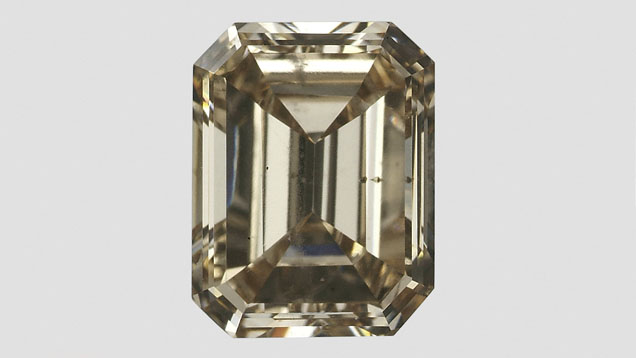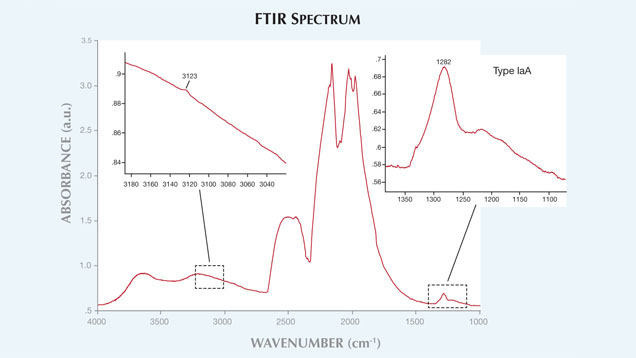CVD-Grown Synthetic Diamond with Aggregated Nitrogen Impurities

Recently, an unusual 0.94 ct Fancy yellow-brown emerald cut (figure 1) was submitted to GIA for a synthetic diamond grading report. It contained a cloud of black needle-like inclusions occurring along a plane (figure 2) and showed weak green transmission with fiber-optic illumination. Under cross-polarized light, the synthetic diamond displayed a black and white mottled strain pattern, somewhat similar in appearance to the crosshatched “tatami” pattern usually seen in natural type IIa diamonds (figure 15, right). FTIR spectroscopy revealed that it was type IaA, with approximately 10 ppm of aggregated nitrogen atom pairs in the lattice (figure 16). DiamondView imaging showed red fluorescence and planar growth patterns that are common in CVD synthetic diamonds (figure 17). Photoluminescence spectroscopy detected silicon-vacancy defects introduced during the CVD growth process (not shown), and further examination of the FTIR spectrum revealed a very weak peak at 3123 cm–1 (again, see figure 3), confirming this was an as-grown CVD synthetic diamond (P.M. Martineau et al., “Identification of synthetic diamond grown using chemical vapor deposition [CVD],” Spring 2004 G&G, pp. 2–25).

Figure 2. A cloud of needle-like inclusions was observed in the synthetic diamond (left, magnified 50×). The side view clearly showed that the cloud was confined to a plane (center; magnified 45×). With cross-polarized light, the mottled and crosshatched strain pattern was visible (right; magnified 15×). Photo by Troy Ardon.
This marked GIA’s first examination of a CVD synthetic diamond with aggregated nitrogen impurities. During HPHT treatment, nitrogen atoms typically start to aggregate as pairs at temperatures above 2000°C. Although some CVD synthetics are HPHT-treated to remove brown coloration, spectroscopic evidence indicates that this sample had not undergone such treatment. It is unclear how the nitrogen impurities came to be in their aggregated state. It is possible that a type IaA natural diamond was used as a seed crystal for multi-stage CVD growth and remains within the current gemstone, thereby producing the FTIR results. However, no clear evidence of this scenario was uncovered. More research is currently under way to understand this unusual CVD synthetic diamond with aggregated nitrogen impurities.
Figure 3. FTIR spectroscopy revealed that the CVD synthetic diamond was type IaA with aggregated nitrogen atom pairs, the first CVD synthetic diamond GIA has seen with this configuration of nitrogen impurities. The 3123 cm–1 peak confirms this is an as-grown CVD diamond.
.jpg)


